A Better Life tells a story about Los Angeles and its historic Latino communities through the experience of one undocumented immigrant (Carlos) and his son (Luis). The film is extraordinary, both for the story that it tells and for its setting. While numerous films have been set in LA, only a handful have ever been set in East LA, and only one with as much authenticity (My Family). Like Buñuel with Los olvidados, Chris Weitz would not have been able to achieve the authenticity that he does without the help of people with intimate familiarity of the communities portrayed. One of the consultants was Father Greg Boyle, who for the past thirty years has run a successful gang intervention program in East LA. All of the actors playing the role of gang members were cast from Father Boyle’s Homeboy Industries and are former gang members. Richard Cabral (Ruthie’s cousin), interestingly, has continued to act and has received critical acclaim for his performance in the series American Crime. If you want to do something today to renew your faith in humanity and feed your soul, watch this Tedx Talk in which Father Boyle discusses his life’s work.
The map below shows the different locations of the opening montage sequence of the film when Carlos and Blasco leave Ramona Gardens and head to Santa Monica, passing the historic Evergreen Cemetery in Boyle Heights before turning West and crossing one of several bridges that connect East LA to downtown, and from there continuing west through MacArthur Park and on to Santa Monica. This is an indirect route to the coast from Ramona Gardens, but it serves the purpose of showing the viewer some of the areas of the city that have the highest concentrations of recent immigrants from Mexico and Central America. Later in the film, Carlos and Luis go to a part of South Los Angeles that is historically African American and that has a growing concentration of Central American immigrants. The rodeo (charrería) scene was filmed in Pico Rivera and the night club scene in Bell (both southeast of downtown). All of the spaces in the film are real places, including the public housing unit where Ruthie lives (which is in Ramona Gardens). The only geographical inconsistency is the high school (Locke High in South LA), which was probably selected for its prison-like design. Luis and Ruthie would have attended Lincoln High in nearby Montecito Heights.
Latino communities exist all across Southern California, and the film only shows us a few of them (Boyle Heights being the most historically significant). This article discusses the complex ethnic geographies of Los Angeles and highlights contemporary segregation patterns.
Click on image to redirect to interactive Map

Prior to reading this, I did not understand the extent of the importance of location in the film. I could tell the movie was trying to show locations that represent poverty, but I did not understand the full extent and the connection to such an exact location. Being unfamiliar with California, I had no idea about the divide in Los Angles between East, South, and downtown. Connecting it with other movies, location and setting play an essential role in all the movies. Even though the location is not named in El Violin, in all the movies locations represents identity and fate. The location and setting of the movies also represent Zavatinni’s point of portraying poverty and the neo-realistic trait of having filmmakers go outside of the studio in real life places.
I thought one of the real strengths of the film was in creating a sense that each geographic location is highly separated, as if the poor are cordoned off from the rich and then each racial/social/ethnic group lives in their own community. Living in Chicago it was encouraging to see the kind of racial segregation that we share with Los Angeles being portrayed on film. Along with the montage scenes of the actual neighborhoods and the protest it really created a documentary-like realness that Zavattini speaks of in “Some Ideas on the Cinema.” And Emily, I think your bringing up El Violin is very interesting because I also was interested in them not naming the location. Despite it being strongly suggested, as discussed in class, that it is in Mexico, I loved that the location wasn’t named, as this provides greater universality to the story, both as a literal story of rebellion and as a metaphorical struggle for liberation from oppression.